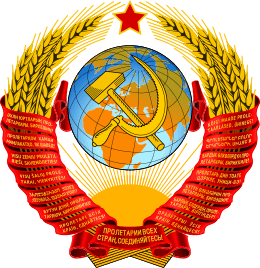Soviet occupation of Manchuria
The Soviet occupation of Manchuria took place after the Red Army invaded the Japanese puppet state of Manchukuo in August 1945 and would continue until the last of the Soviet forces left in May 1946.
Soviet occupation of Manchuria | |||||||||||||||||||||||
|---|---|---|---|---|---|---|---|---|---|---|---|---|---|---|---|---|---|---|---|---|---|---|---|
| 1945–1946[lower-alpha 1] | |||||||||||||||||||||||
.svg.png) Flag of the Soviet Union (1936-1955) | |||||||||||||||||||||||
| Status | Soviet occupation | ||||||||||||||||||||||
| Capital | Shenyang (Command Station) | ||||||||||||||||||||||
| Common languages | Chinese (Northeastern Mandarin) Japanese Russian | ||||||||||||||||||||||
| Government | Military occupation | ||||||||||||||||||||||
| Soviet commander | |||||||||||||||||||||||
• 1946 | Rodion Malinovsky | ||||||||||||||||||||||
| History | |||||||||||||||||||||||
• Soviet troops invaded Manchuria | 9 August 1945 | ||||||||||||||||||||||
• Withdrawal of all Soviet troops in Manchuria | 3 May 1946[lower-alpha 2] | ||||||||||||||||||||||
| Currency | yuan | ||||||||||||||||||||||
| Time zone | UTC+8 | ||||||||||||||||||||||
| |||||||||||||||||||||||
| Today part of | China Russia | ||||||||||||||||||||||
History
On February 11, 1945, the Big Three (Roosevelt, Churchill, and Stalin) signed the Yalta Agreement, which obligated the Soviet Union to enter the war against Japan within three months after Germany's surrender in exchange for territorial concessions and Soviet influence in post-war Manchuria.
True to his word, Stalin would order the invasion of Manchukuo on August 9, 1945, which broke the 1941 pact between the two countries and inaugurated in one of the largest campaigns in the Second World War. The massive and battle-hardened Red Army not only steamrolled into Manchuria, brushing aside scattered Japanese resistance, but they liberated Mengjiang (Inner Mongolia), southern Sakhalin, and the northern half of the Korean peninsula as well. The rapid defeat of the Kwantung Army in Manchuria, along with the recent atomic bombing of Hiroshima and Nagasaki by the Americans, contributed significantly to the Japanese surrender on the 15th.[1][2][3][4]
The invasion, along with the surrender, prompted the Kuomintang to jockey for position vis-a-vis the Chinese Communists in mainland China. They did so by signing a Treaty of Friendship and Alliance with the Soviet Union on August 14, 1945, which affirmed Chinese sovereignty over Manchuria in exchange for Chinese recognition of the Soviet-aligned Mongolian People's Republic. The Soviets began withdrawing from Manchuria within three weeks of Japan's surrender—although they would delay the process several times. The resumption of the Chinese Civil War in early 1946 prompted the Red Army to finish the withdrawal, but not before secretly turning Manchuria over to the Chinese Communists in March in violation of the Agreement. [5]
See also
- Soviet invasion of Manchuria
- Soviet occupation of Mongolia
- Soviet occupations
References
Note
- Occupation of Lüshun base until 1955
- Occupation of Lüshun base until 1955
Citations
- Robert Butow, Japan's Decision to Surrender, Stanford University Press, 1954 ISBN 978-0-8047-0460-1.
- Richard B. Frank, Downfall: The End of the Imperial Japanese Empire, Penguin, 2001 ISBN 978-0-14-100146-3.
- Robert James Maddox, Hiroshima in History: The Myths of Revisionism, University of Missouri Press, 2007 ISBN 978-0-8262-1732-5.
- Tsuyoshi Hasegawa, Racing the Enemy: Stalin, Truman, and the Surrender of Japan, Belknap Press, 2006 ISBN 0-674-01693-9.
- 作者:劉向上 (2009-04-20). "张莘夫事件"与苏军撤出东北 (in Chinese). 揚子晚報網. Archived from the original on 2013-11-01. Retrieved 2009-04-20.
